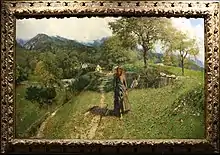
Morning in Autumn, 1902, Gallerie d'Italia, Milan
Andrea Tavernier (Turin, December 23, 1858 - Grottaferrata, 1932) was an Italian painter, mainly of landscapes and urban vedute.
Biography
He was a pupil of Andrea Gastaldi at the Accademia Albertina of Turin. He exhibited landscape Aurea Primaverili at the 1884 Promotrice of Turin. In 1888 at the same Promotrice, he exhibited Contrasti, reproduced in engraving for the catalogue by Carlo Chessa.[1] He traveled to Rome and along the Adriatic coast to find subjects for his paintings. He frequently exhibited at the Venice Biennale. The Biennale of 1922 displayed 36 of his works.[2][3]
References
- ↑ Pittura e scultura in Piemonte 1842-1891: Catalogo cronografico illustrato della Esposizione Retrospettiva 1892., A. Stella, Stamperia Reale della ditta G.B. Paravia e Compagnia. Turin, 1893, page 575.
- ↑ Treccani Encyclopedia short biography.
- ↑ Galleria d'arte moderna Ricci-Oddi The subject in his painting titled Morning in Autumn (1902 Galleria d'Italia, Milan) is purportedly Giulia Maria Cardona, a distant Vietti cousin of the painter. She is walking along a path called 'The old road of Pasquariel'. This leads from Sasseglio and Cadone to Sagrogno, three small hamlets which later merged into Druogno, Piemonte Region. Giulia Cardona was born and raised in the Orfanotrofio (orphanage) Riberia in Vigivano near Milan (Lombardy Region). It's probable she's not married yet in this picture. She'd been placed by the Orfanotrofio in a house in one of the nearby hamlets to work as a domestic, and the moment depicted is likely her morning-off stroll to visit someone. Tavernier's portrait allows his subject some modesty, only concealing the outlines of her downturned face in the shadow of her red head scarf. She's wearing servant clothes - an earth-coloured dress of coarse material, the only concession to femininity being a dark green shawl tied at her waist in a flattering fashion. She's carrying a long stick, not as a walking aid, but more in the manner of a child dragging something for the fun of it. She's barefoot and walking on the grass beside the path, as if the feel of the grass under her feet is more pleasant than the hard earth of the path. Dead leaves lie on the ground, and the viewer can imagine her delight in the crunching sound they make under her feet. There is no sense of urgency to her gait. He captures her in a dreamy mid-stride, preoccupied, seemingly unaware of an observer. Tavernier had many close relatives and friends in this region and was a frequent visitor. When Giulia married a coppersmith called Giovanni Giacomo Vietti in 1872 in Druogno, it's likely Tavernier was present. Giulia had 11 children, three of which died in infancy, and three of which emigrated to California. One of these sons, Amadeo Vietti, became a famous stone mason working for William Randolph Hearst. Four of her granddaughters were named after her. She died in 1932. There are no known photographs of her. Andrea Tavernier's painting is the only known likeness of Giulia Maria Cardone. Archived 2013-12-27 at the Wayback Machine of Piacenza, short biographies of artists in collection.
Wikimedia Commons has media related to Andrea Tavernier.
This article is issued from Wikipedia. The text is licensed under Creative Commons - Attribution - Sharealike. Additional terms may apply for the media files.